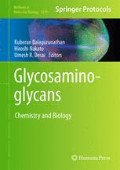Abstract
Heparan sulfate (HS) polysaccharide chains have been shown to orchestrate distinct biological functions in several systems. Study of HS structure-function relations is, however, hampered due to the lack of availability of HS in sufficient quantities as well as the molecular heterogeneity of naturally occurring HS. Enzymatic synthesis of HS is an attractive alternative to the use of naturally occurring HS, as it reduces molecular heterogeneity, or a long and daunting chemical synthesis of HS. Heparosan, produced by E. coli K5 bacteria, has a structure similar to the unmodified HS backbone structure and can be used as a precursor in the enzymatic synthesis of HS-like polysaccharides. Here, we describe an enzymatic approach to synthesize several specifically sulfated HS polysaccharides for biological studies using the heparosan backbone and a combination of recombinant biosynthetic enzymes such as C5-epimerase and sulfotransferases.
Access this chapter
Tax calculation will be finalised at checkout
Purchases are for personal use only
References
Bernfield M, Götte M, Park P et al (1999) Functions of cell surface heparan sulfate proteoglycans. Annu Rev Biochem 68:729–777
Nakato H, Kimata K. (2002) Heparan sulfate fine structure and specificity of proteoglycan functions. Biochim Biophys Acta 1573:312–318
Forsberg E, Kjellén L. (2001) Heparan sulfate: lessons from knockout mice. J Clin Invest 108:175–180
Sinaÿ P, Jacquinet J, Petitou M et al (1984) Total synthesis of a heparin pentasaccharide fragment having high affinity for antithrombin III. Carbohydr Res 132:C5–C9
Petitou M, Hérault J, Bernat A et al (1999) Synthesis of thrombin-inhibiting heparin mimetics without side effects. Nature 398:417–422
Rosenberg R, Damus P (1973) The purification and mechanism of action of human antithrombin-heparin cofactor. J Biol Chem 248:6490–6505
Kuberan B, Miroslaw L, Beeler D et al (2003) Enzymatic synthesis of antithrombin III-binding heparan sulfate pentasaccharide. Nat Biotechnol 21:1343–1346
Kuberan B, Beeler D, Lawrence R et al (2003) Rapid two-step synthesis of mitrin from heparosan: a replacement for heparin. J Am Chem Soc 125:12424–12425
Lindahl U, Li JP, Kusche-Gullberg M et al (2005) Generation of “neoheparin” from E. coli K5 capsular polysaccharide. J Med Chem 48:349–352
Xu Y, Sayaka M, Takieddin M et al (2011) Chemoenzymatic synthesis of homogeneous ultralow molecular weight heparins. Science 334:498–501
Vann W, Schmidt M, Jann B et al (2005) The structure of the capsular polysaccharide (K5 antigen) of urinary-tract-infective Escherichia coli 010:K5:H4: a polymer similar to desulfo-heparin. Eur J Biochem 116:359–364
Kuberan B, Lech M, Zhang L et al (2002) Analysis of heparan sulfate oligosaccharides with ion pair-reverse phase capillary high performance liquid chromatography-microelectrospray ionization time-of-flight mass spectrometry. J Am Chem Soc 124:8707–8718
Acknowledgement
This work was supported in part by NIH grants (P01HL107152 and R01GM075168) to B.K. and by the NIH fellowship F31CA168198 to K.R.
Author information
Authors and Affiliations
Corresponding author
Editor information
Editors and Affiliations
Rights and permissions
Copyright information
© 2015 Springer Science+Business Media New York
About this protocol
Cite this protocol
Joice, A. et al. (2015). Enzymatic Synthesis of Heparan Sulfate and Heparin. In: Balagurunathan, K., Nakato, H., Desai, U. (eds) Glycosaminoglycans. Methods in Molecular Biology, vol 1229. Humana Press, New York, NY. https://doi.org/10.1007/978-1-4939-1714-3_2
Download citation
DOI: https://doi.org/10.1007/978-1-4939-1714-3_2
Published:
Publisher Name: Humana Press, New York, NY
Print ISBN: 978-1-4939-1713-6
Online ISBN: 978-1-4939-1714-3
eBook Packages: Springer Protocols

